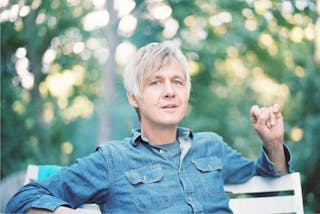Art Alum Receives $55,000 Guggenheim Fellowship
News
May 2, 2018 | Noon
By Jenny Hudalla '15, content specialist

Chris Larson ’90 is an internationally recognized artist and an associate professor of sculpture at the University of Minnesota.
Disbelief. That’s what Chris Larson ’90 felt when he was awarded the esteemed Guggenheim Fellowship—one of the highest honors in art and academia—last month.
Candidates must apply to the Guggenheim Foundation to be considered in the annual competition, which recognizes individuals for exceptional scholarship or creative ability in the arts. Chosen as one of 175 standouts in an applicant pool of more than 3,000, Larson received a $55,000 grant to spend one year working with as much creative freedom as possible.
“It’s the most prestigious award I’ve ever won,” says Larson, who is also a recipient of a Bush Foundation Fellowship, a McKnight Foundation Fellowship, a Louis Comfort Tiffany Award, and a New Work Project Grant from The Harpo Foundation. “I still can’t believe it.”
After graduating from Bethel with a Bachelor of Fine Arts, Larson went on to earn a Master of Fine Arts from Yale University. He now works as an associate professor of sculpture at the University of Minnesota and travels frequently as a practicing artist. His work is rooted in sculpture, but he also incorporates video, photography, drawing, and sound.
Professor of Art Wayne Roosa, who still keeps in touch with Larson, isn’t surprised by his former student’s success. “As a student, Chris was quiet but always working,” Roosa says. “He valued making new work far more than talking about work, and he was fearless in exploring new ideas and new ways to work with materials.”
Because the Guggenheim Foundation aims to provide Fellows with blocks of time in which they can work without restrictions, Fellows may spend their grant funds in any manner they deem necessary to their work. Larson has chosen to move his studio to an abandoned garment factory in Smithville, Tennessee, where Ralph Lauren Polo, Converse, and Land’s End produced clothing. Though he doesn’t know which form his next project will take, Larson is interested in exploring how workspaces impact perceptions of social class and identity.
“A lot of my work deals with labor,” Larson says. “I’m interested in the residue of labor left in this factory, and how that affects the way we understand the people who worked here.”
Left untouched for almost half a century, the basement-level shop employed more than 100 women whose legacies now lie within the millions of zippers, thousands of spools of thread, and hundreds of sewing machines scattered about the 12,000 square-foot-space. The move is a deviation from Larson’s most recent work, which has focused on replicating and relocating historical architectural sites—like the Lorraine Motel sign that now looms over Highway 8 in Shafer, Minnesota.
“You could consider the clothing factory a historical site,” he says, “but I’m moving my whole studio. That’s something new within my practice. I feel like there’s a change coming on.”
Larson’s work has been displayed worldwide, from the Walker Art Center in Minneapolis to the Staatliche Museen in Berlin. In addition to teaching a full course load, he’s also the director of undergraduate studies at the University of Minnesota and serves as publisher of Inreview, a quarterly art publication in the Twin Cities. This is the first time Larson will take a break in 12 years.
“It’s unfamiliar territory, but that’s a common thread in my work—even going back to my time at Bethel,” Larson says. “I’m a shape-shifter. I’m continually trying to take risks and open new doors.”
Learn more about Larson’s work and the Department of Art and Design at Bethel.